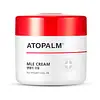What's inside
What's inside
 Key Ingredients
Key Ingredients

 Benefits
Benefits

 Concerns
Concerns

 Ingredients Side-by-side
Ingredients Side-by-side

Water
Skin ConditioningGlycerin
HumectantPropanediol
SolventMyristoyl/Palmitoyl Oxostearamide/Arachamide Mea
Skin ConditioningCaprylic/Capric Triglyceride
MaskingCetearyl Ethylhexanoate
EmollientCetearyl Alcohol
EmollientPolyglyceryl-10 Distearate
EmulsifyingGlyceryl Stearate
EmollientHydrogenated Vegetable Oil
EmollientOlea Europaea Fruit Oil
MaskingHelianthus Annuus Seed Oil
EmollientCamellia Sinensis Seed Oil
HumectantSimmondsia Chinensis Seed Oil
EmollientVitis Vinifera Seed Oil
EmollientCarthamus Tinctorius Seed Oil
MaskingSunflower Oil Decyl Esters
Skin ConditioningPortulaca Oleracea Extract
Skin ConditioningViscum Album Fruit Extract
SoothingSorbitan Stearate
EmulsifyingBeta-Glucan
Skin ConditioningTocopherol
AntioxidantPhytosterols
Skin ConditioningCarbomer
Emulsion StabilisingAllantoin
Skin ConditioningStearic Acid
CleansingArginine
MaskingSodium Phytate
Sodium Hyaluronate
HumectantAnthemis Nobilis Flower Oil
MaskingSalvia Officinalis Oil
MaskingSantalum Album Oil
Masking1,2-Hexanediol
Skin ConditioningCaprylyl Glycol
EmollientWater, Glycerin, Propanediol, Myristoyl/Palmitoyl Oxostearamide/Arachamide Mea, Caprylic/Capric Triglyceride, Cetearyl Ethylhexanoate, Cetearyl Alcohol, Polyglyceryl-10 Distearate, Glyceryl Stearate, Hydrogenated Vegetable Oil, Olea Europaea Fruit Oil, Helianthus Annuus Seed Oil, Camellia Sinensis Seed Oil, Simmondsia Chinensis Seed Oil, Vitis Vinifera Seed Oil, Carthamus Tinctorius Seed Oil, Sunflower Oil Decyl Esters, Portulaca Oleracea Extract, Viscum Album Fruit Extract, Sorbitan Stearate, Beta-Glucan, Tocopherol, Phytosterols, Carbomer, Allantoin, Stearic Acid, Arginine, Sodium Phytate, Sodium Hyaluronate, Anthemis Nobilis Flower Oil, Salvia Officinalis Oil, Santalum Album Oil, 1,2-Hexanediol, Caprylyl Glycol
Water
Skin ConditioningGlycerin
HumectantC10-18 Triglycerides
EmollientCoco-Caprylate/Caprate
EmollientCoco-Caprylate
EmollientPropanediol
SolventCetyl Alcohol
EmollientOryza Sativa Starch
AbsorbentGlyceryl Stearate
EmollientSodium Ascorbyl Phosphate
AntioxidantRetinyl Palmitate
Skin ConditioningHyaluronic Acid
HumectantCeramide Ng
Skin ConditioningMadecassoside
AntioxidantAsiaticoside
AntioxidantMadecassic Acid
Skin ConditioningAsiatic Acid
Skin ConditioningMannitol
HumectantXanthan Gum
EmulsifyingPEG-75 Stearate
Hydroxypropyl Starch Phosphate
Phosphatidylcholine
EmulsifyingCeteth-20
CleansingCholesterol
EmollientSteareth-20
CleansingAcrylates/C10-30 Alkyl Acrylate Crosspolymer
Emulsion StabilisingHydrogenated Phosphatidylcholine
EmulsifyingPentylene Glycol
Skin ConditioningDecyl Glucoside
CleansingTocopheryl Acetate
AntioxidantSodium Chloride
MaskingTocopherol
AntioxidantCaprylyl Glycol
EmollientAlcohol
AntimicrobialPotassium Sorbate
PreservativeSodium Benzoate
MaskingEthylhexylglycerin
Skin ConditioningPhenoxyethanol
PreservativeWater, Glycerin, C10-18 Triglycerides, Coco-Caprylate/Caprate, Coco-Caprylate, Propanediol, Cetyl Alcohol, Oryza Sativa Starch, Glyceryl Stearate, Sodium Ascorbyl Phosphate, Retinyl Palmitate, Hyaluronic Acid, Ceramide Ng, Madecassoside, Asiaticoside, Madecassic Acid, Asiatic Acid, Mannitol, Xanthan Gum, PEG-75 Stearate, Hydroxypropyl Starch Phosphate, Phosphatidylcholine, Ceteth-20, Cholesterol, Steareth-20, Acrylates/C10-30 Alkyl Acrylate Crosspolymer, Hydrogenated Phosphatidylcholine, Pentylene Glycol, Decyl Glucoside, Tocopheryl Acetate, Sodium Chloride, Tocopherol, Caprylyl Glycol, Alcohol, Potassium Sorbate, Sodium Benzoate, Ethylhexylglycerin, Phenoxyethanol
 Reviews
Reviews

Ingredients Explained
These ingredients are found in both products.
Ingredients higher up in an ingredient list are typically present in a larger amount.
Caprylyl Glycol is a humectant and emollient, meaning it attracts and preserves moisture.
It is a common ingredient in many products, especially those designed to hydrate skin. The primary benefits are retaining moisture, skin softening, and promoting a healthy skin barrier.
Though Caprylyl Glycol is an alcohol derived from fatty acids, it is not the kind that can dry out skin.
This ingredient is also used as a preservative to extend the life of products. It has slight antimicrobial properties.
Learn more about Caprylyl GlycolGlycerin is already naturally found in your skin. It helps moisturize and protect your skin.
A study from 2016 found glycerin to be more effective as a humectant than AHAs and hyaluronic acid.
As a humectant, it helps the skin stay hydrated by pulling moisture to your skin. The low molecular weight of glycerin allows it to pull moisture into the deeper layers of your skin.
Hydrated skin improves your skin barrier; Your skin barrier helps protect against irritants and bacteria.
Glycerin has also been found to have antimicrobial and antiviral properties. Due to these properties, glycerin is often used in wound and burn treatments.
In cosmetics, glycerin is usually derived from plants such as soybean or palm. However, it can also be sourced from animals, such as tallow or animal fat.
This ingredient is organic, colorless, odorless, and non-toxic.
Glycerin is the name for this ingredient in American English. British English uses Glycerol/Glycerine.
Learn more about GlycerinGlyceryl Stearate is a mix of glycerin and stearic acid.
It is used to stabilize the mixing of water and oil ingredients. By preventing these ingredients from separating, it can help elongate shelf life. It can also help thicken the product's texture.
As an emollient, it helps soften skin and supports barrier-replenishing ingredients.
In cosmetics, Glyceryl Stearate is often made from vegetable oils or synthetically produced.
This ingredient may not be fungal-acne safe
Fun fact: The human body also creates Glyceryl Stearate naturally.
Learn more about Glyceryl StearatePropanediol is an all-star ingredient. It softens, hydrates, and smooths the skin.
It’s often used to:
Propanediol is not likely to cause sensitivity and considered safe to use. It is derived from corn or petroleum with a clear color and no scent.
Learn more about PropanediolTocopherol (also known as Vitamin E) is a common antioxidant used to help protect the skin from free-radicals and strengthen the skin barrier. It's also fat soluble - this means our skin is great at absorbing it.
Vitamin E also helps keep your natural skin lipids healthy. Your lipid skin barrier naturally consists of lipids, ceramides, and fatty acids. Vitamin E offers extra protection for your skin’s lipid barrier, keeping your skin healthy and nourished.
Another benefit is a bit of UV protection. Vitamin E helps reduce the damage caused by UVB rays. (It should not replace your sunscreen). Combining it with Vitamin C can decrease sunburned cells and hyperpigmentation after UV exposure.
You might have noticed Vitamin E + C often paired together. This is because it is great at stabilizing Vitamin C. Using the two together helps increase the effectiveness of both ingredients.
There are often claims that Vitamin E can reduce/prevent scarring, but these claims haven't been confirmed by scientific research.
Learn more about TocopherolWater. It's the most common cosmetic ingredient of all. You'll usually see it at the top of ingredient lists, meaning that it makes up the largest part of the product.
So why is it so popular? Water most often acts as a solvent - this means that it helps dissolve other ingredients into the formulation.
You'll also recognize water as that liquid we all need to stay alive. If you see this, drink a glass of water. Stay hydrated!
Learn more about Water